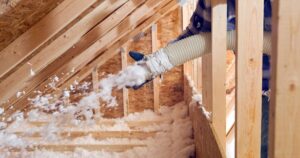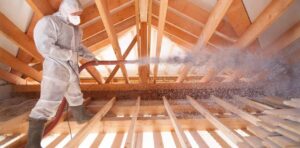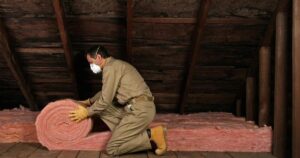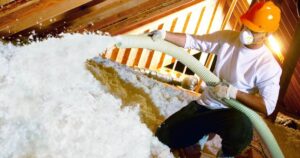If you have an open ceiling with exposed rafters, insulating them can significantly improve energy efficiency and make your living space more comfortable. Whether it’s an attic, a loft, or any other open ceiling area, proper insulation helps maintain consistent temperatures and reduces energy bills.
In this comprehensive guide, we’ll walk you through the steps to effectively insulate open ceiling rafters.
Materials and Tools You’ll Need

- Insulation Material
Choose an appropriate insulation type for your project. Common options include fiberglass batts, spray foam, or rigid foam board. The choice depends on factors like your climate, budget, and the available space.
- Insulation Hangers or Supports
These are used to hold insulation in place. The type of support may vary based on your chosen insulation material.
- Utility Knife
For cutting insulation material to fit perfectly between rafters.
- Safety Gear
Ensure you have gloves, safety glasses, and a dust mask to protect yourself when working with insulation.
- Measuring Tape
Accurate measurements are crucial for a precise fit.
- Staple Gun
Required if you choose to secure insulation supports to the rafters.
- Caulk Gun
For sealing gaps and joints.
- Foam Sealant
To seal gaps around the edges of insulation.
Now, let’s dive into the insulation process step by step:
- Safety Precautions
Before you begin, ensure that your attic or open ceiling space is well-ventilated. Wear safety gear, including gloves, safety glasses, and a dust mask to protect yourself from insulation fibers. Safety should always be a top priority.
- Assess the Space
Measure the distance between your rafters and the available depth for insulation. This measurement will help you determine the R-value (thermal resistance) you need for your insulation. Adequate R-value is crucial for efficient insulation.
- Choose the Right Insulation
Select the insulation type that best suits your project. Your choice should consider factors like your local climate, budget, and available space. Common options include:
- Fiberglass Batts
These are flexible insulation panels and are a cost-effective choice. They come in various R-values and can be used for most open-ceiling applications.
- Spray Foam
This option provides excellent insulation and can be applied in hard-to-reach places. It’s particularly useful for irregularly shaped spaces.
- Rigid Foam Board
These boards offer high R-values per inch, making them suitable for areas with limited space.
- Install Insulation Hangers
For insulation like fiberglass batts or other materials that need support, install insulation hangers or supports between the rafters. These hangers will keep the insulation in place and prevent it from sagging over time.
- Cut and Install Insulation
Measure and cut the insulation pieces to fit snugly between the rafters. Ensure that they are placed without compression to maintain their insulating properties. If using fiberglass batts, ensure that the paper vapor barrier faces the heated living space.
- Seal Gaps and Joints
To prevent air leakage and optimize your insulation’s effectiveness, use a caulking gun or foam sealant to seal any gaps or joints between the insulation and the rafters.
- Cover with Finish Material
Depending on your preferences and local building codes, you may need to cover the insulation with drywall or another finishing material for both fire safety and aesthetics.
- Install Proper Ventilation
In cases where you’re insulating an attic, it’s vital to provide adequate ventilation to prevent moisture buildup. Install soffit and ridge vents to facilitate proper air circulation.
- Check Local Codes
Make sure to review your local building codes and regulations to ensure your insulation project complies with the necessary standards and requirements.
- Safety Cleanup
After completing the installation, carefully clean up the area and dispose of any waste materials in accordance with local regulations.
Conclusion
insulating open ceiling rafters is a worthwhile investment in your home’s energy efficiency and comfort. The choice of insulation material and the installation process may vary based on your specific needs, local climate, and budget.
Research thoroughly and consider consulting with a professional if you have any concerns about your insulation project. With the right insulation, you can enjoy a more comfortable and energy-efficient living space.
FAQs
How do you insulate an open ceiling?
The easiest way is to use insulating rigid foam sheets cut to size and friction fitted between the rafters before the drywall is installed. Seal any gaps with expanding foam. Remember to leave a one-inch gap between the foam and the roof deck to allow air movement.
How do you install insulation in an exposed ceiling?
If the ceiling cavity is exposed, insulation batts can be pushed between the ceiling joists from below with a long stick. It’s important that you have the right-sized batt so that it will fit snugly between the joists with no gaps.
Should I insulate the rafters or ceiling?
If you are deciding between insulating the roof deck or the ceiling, Insulating your ceiling should be the priority. Not only is it easier but ceiling insulation is beneficial in a number of ways: Keeps the temperature in the building regulated. Saves on energy costs.
How to insulate for cheap?
5 DIY Ways to Insulate Your Home on the Cheap
Cover any air leaks with weatherproofing. Use weatherproofing strips and caulking to seal any air leaks in your doors and windows. …
1. Add thick curtains to your windows. …
2. Fix drafty doors with a door snake. …
3. Plug your chimney when not in use. …
4. Seal your attic air leaks.










